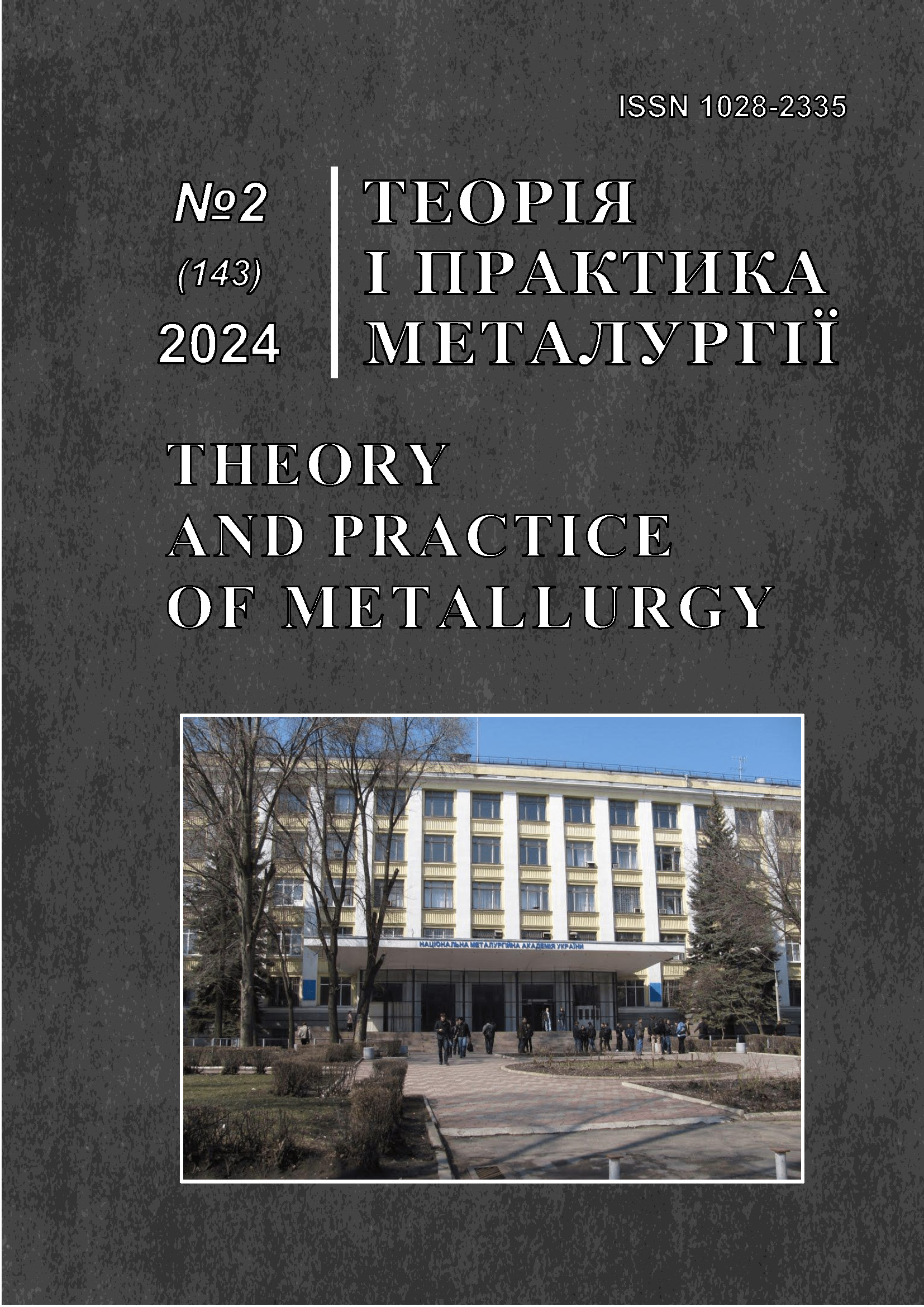Reconstruction of a chamber furnace
DOI:
https://doi.org/10.15802/tpm.2.2024.02Keywords:
chamber furnace, heat accumulation, refractory lining, fuel economyAbstract
Objective. The paper considers the issue of a chamber furnace reconstruction for improving of their energy efficiency. Methods. The chamber furnace is heated by natural gas and operates at a constant temperature in its working chamber. The nominal capacity of the furnace is 100 kg/h. According to the design, the furnace walls are two-layered: the refractory layer made of chamotte (B class) is 120 mm, and the heat-insulating layer made of diatomite bricks is 60 mm. To study the temperature fields and heat losses through the lining during the operation of the furnace, the authors developed a two-dimensional mathematical model of heat conduction through a flat wall for an unsteady-state temperature condition. Findings. Using the mathematical model, numerical calculations were performed for the furnace of the basic design. It was considered three variants of the furnace lining reconstruction. Three variants of the furnace lining reconstruction were considered, which involved replacing the furnace brick lining with a lining made of ceramic fibre (MKRV-340), whose thickness was 180, 120, and 60 mm according to the number of the reconstruction opinion. As the results of the calculation are the heat losses of lining and the temperature distribution in the lining were determined. That made possible to assess the fuel consumptions which covered heat losses and the fuel costs as well as the weight and cost of the lining. The scientific novelty of the work is in the revealed relationship between the design and operational parameters of the furnace, and the practical value of the work is in the developed recommendations for choosing a rational thickness of the furnace lining layer of the ceramic fibre, depending on the expected operation life of the furnace.
References
Iasnogor, V. I., Eremin, A. O., Gupalo, O. V., & Matukhno, O. V. (2017). Konstruirovanie Nagrevatelnykh Pechei Novogo Pokoleniia. Energetické Procesy 2017.Košice, 153–160
Ginkul, S. I., Biryukov, A. B., Ivanova, A. A., & Gnitiev, P. A. (2018). Predictive Mathematical Model of the Process of Metal Heating in Walking-Beam Furnaces. Metallurgist, 62, 15–21. https://doi.org/10.1007/s11015-018-0619-9
Varga, A., Kizek, J., Rimár, M., Fedák, M., Čorný, I., & Lukáč, L. (2023). Modeling of Heat Flux in a Heating Furnace. Computation, 11 (7), 144. https://doi.org/10.3390/computation11070144
Huang, H., Zheng, Z., Yao, J., Zhang, L., Bu, S., Xu, F., Xu, W., & Ding, H. (2023). The Quantitative Study on the Influence of Operating Parameters Upon Thermal Performance of Heating Furnace. ASME. J. Thermal Sci. Eng. Appl. 15 (2), 021001. https://doi.org/10.1115/1.4055768
Andreev, S. (2019). System of Energy-Saving Optimal Control of Metal Heating Process in Heat Treatment Furnaces of Rolling Mills. Machines, 7 (3), 60. https://doi.org/10.3390/machines7030060
Bao, Q., Zhang, S., Guo, J., Zhengguang, X., & Zhenquan, Z. (2022). Modeling of Dynamic Data-driven Approach for the Distributed Steel Rolling Heating Furnace Temperature Field. Neural. Comput. & Applic. 34, 8959–8975 (2022). https://doi.org/10.1007/s00521-022-06917-y
Bao, Q., Zhang, S., Guo, J., Ding, D., & Zhang, Zh. (2023). Hierarchical Structure Optimal Setting Approach for Production Indexes of the Rolling Heating Furnace Temperature Field. Journal of Intelligent & Fuzzy Systems, 45 (1), 1663-1681, 2023. https://doi.org/10.3233/JIFS-223441
Rimar, M., Kulikov, A., Fedak, M., Yeromin, O., Sukhyy, K., Gupalo, O., Belyanovskaya, E., Berta, R., Smajda, M., & Ratnayake, M. R. (2020). Mathematical Model of a Heating Furnace Implemented with Volumetric Fuel Combustion. Processes, 8 (4), 469. https://doi.org/10.3390/pr8040469
Soroka, B. (2024). Novel Trends of Development and Perfectionthe Modern Heat Exchangers. Energy Technologies & Resource Saving., 80 (2), 54-65. https://doi.org/10.33070/etars.2.2019.07
Wang, Sz., Gu, J., Miao, W., Cheng, Gl., Liu, Kq., Fang, Mh., & Huang, Ch. (2009). Heat Transfer Analysis of Several Industrial Furnace Lining Refractory Structures. Rare Metal Materials and Engineering, 38, 1259-1262.
Kostur, K. (2017). Mathematical Model for Optimisation of a Thicknesses of Furnace Lining. In 18th International Carpathian Control Conference (ICCC), Sinaia, Romania, May 28-31, 2017, 52-57
Gubinskii, V. I., Zgura, A. A., & Krasin, A. V. (2003). Opyt primeneniia voloknistykh materialov dlia futerovki pechei trubnogo proizvodstva. Metallurgicheskaia teplotekhnika, Vol. 9. NMeTAU
Eremin, A. O., Shemet, T. N., & Eremina, O. L. (2006). Ehnergosberezhenie v termicheskikh kamernykh pechakh s glubokim okhlazhdeniem kladki mezhdu nagrevami metalla. Metallurgicheskaia teplotekhnika. ChP Grek O.S.
CHP "NPKF "EhnergoresurS", Zaporozhe. URL: http://www.enresurs.com
Industrial furnace lining. Web-site of “Inventum” company. URL: https://inventum.com.ua/en/futerovka-pechi.html
Gupalo O., Yeromin O., Kabakova L., Kulikov A., Sukhyi M., & Romanko Y. (2023). Study of the Efficiency of Using Renewable Hydrogen in Heating Equipment to Reduce Carbon Dioxide Emissions. IOP Conference Series: Earth and Environmental Science, 1156, 012035. https://doi.org/10.1088/1755-1315/1156/1/012035
Gubinskii, V. I., Timoshpolskii, V. I., Olshanskii, V. M. et al. (2007). Metallurgicheskie pechi : Teoriia i raschety. Vol. 2. Belorusskaia nauka
Brovkin, V. L. (2014). Chislennye metody v inzhenernykh raschetakh. NMeTAU
Downloads
Published
How to Cite
Issue
Section
License
Copyright (c) 2024 Radchenko Yu.M., Gupalo O.V., Yeromin O.O., Gres L.P., Shtatskyi M.O.

This work is licensed under a Creative Commons Attribution 4.0 International License.
Authors retain copyright of the published papers and grant to the publisher the non-exclusive right to publish the article, to be cited as its original publisher in case of reuse, and to distribute it in all forms and media. Articles will be distributed under the Creative Commons Attribution 4.0 International (CC BY 4.0) licence.
Authors can enter the separate, additional contractual arrangements for non-exclusive distribution of the published paper (e.g., post it to an institutional repository or publish it in a book), with an acknowledgement of its initial publication in this journal.




